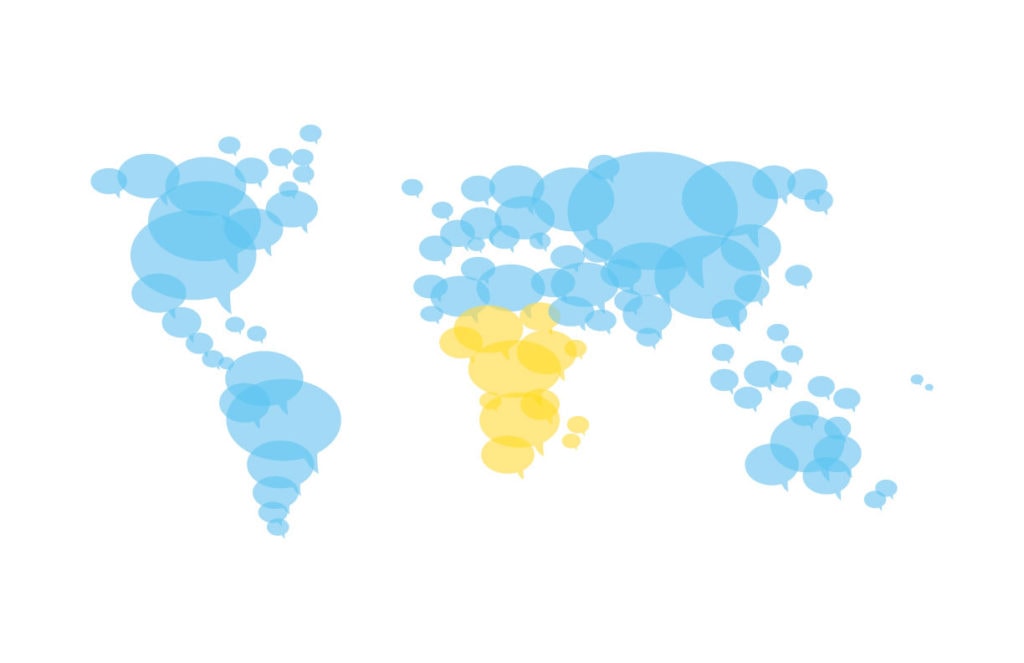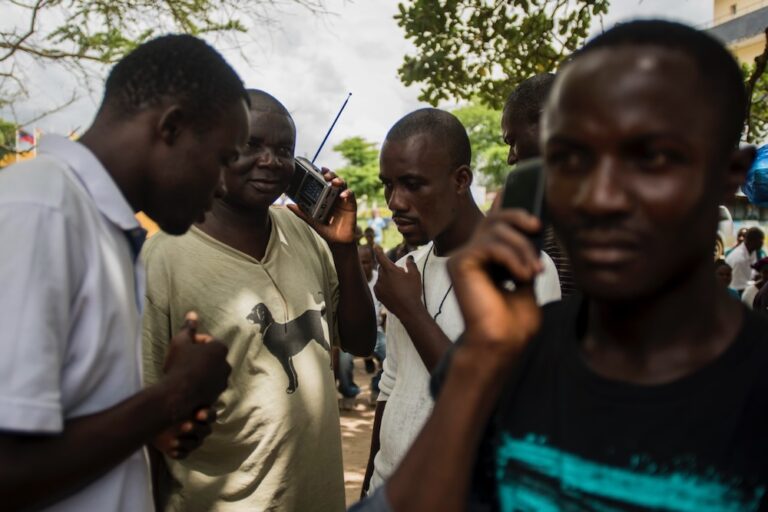Reflecting on events from the first half of 2021, IFEX’s Africa Editor looks at how a more inclusive online platform may help provide journalists and media outlets with the support needed to survive the growing intimidation, harassment, threats and assaults sweeping the continent.
Themes: Safety and justice; civic space; right to information, online expression; diversity, equity and inclusion
On 29 January 2021, at a virtual launch with an audience of 450, keynote speaker South African President Cyril Ramaphosa proudly declared: “Fifty years from now… we will look back with pride at this moment, and at the role that The Digital Platform for the Safety of Journalists will have played to end the harassment, detention and even murder of journalists”.
Conceptualized over the last five years by members of the African Safety of Journalists Network – an association coordinated by UNESCO in Addis Ababa – the platform was established as a tool to counter violations faced by media. The steering committee was made up of an impressive list of influential groups: The African Editors Forum (TAEF), The Federation of African Journalists (FAJ), The Africa Peer Review Mechanism (APRM), UNESCO Addis Ababa Liaison Office to the AU and UNECA, as well as IFEX members the International Federation of Journalists (IFJ) and Article 19.
The timing could not be more judicious. A review of recent attacks against journalists on the continent paints an ugly picture. The lack of interest in carrying out in-depth investigations and bringing perpetrators to justice is fueling the culture of impunity, further emboldening both state and non-state actors to target journalists. As the list of unsolved murders grows, so does the boldness of the attackers.
This year alone, six journalists – Dawit Kebede Araya, Jamal Farah Adan, Betty Muthekele Barasa, Barthelemy Kubanabandu Changamuka, Sisay Fida and Titus Eja Nla Badejo – have been killed.
Sixteen months after Mozambican journalist Ibraimo Mbaruço went missing from the Cabo Delgado area, there are no answers, no accountability. Despite pleas to President Felipe Nyusi and his government by numerous organisations, there has been no investigation into Mbaruco’s disappearance or that of Amade Abubacar in 2019.
The Nigeria Union of Journalists, together with IFEX member the Media Foundation for West Africa, recently published The State of Media Freedom in Nigeria – a detailed report outlining the last five years of violations from arbitrary arrests and detentions to threats, assaults, torture – and murder – as well as arbitrary shutdowns and suspension of media organisations in the country.
Indira Correia Balde, the president of the Union of Journalists and Social Communication Technicians (SINJOTECS), says the threat to journalists’ security has reached alarming levels in Guinea Bissau in recent years. Between July 2020 and March 2021, Capital Radio was ransacked by armed men in military uniform and its reporter Adão Ramalho was assaulted. A week prior to Ramalho’s attack, António Aly Silva, the editor of Ditadura de Consenso, was abducted and savagely assaulted before being dumped outside the capital, Bissau. In January of this year, Bombolom FM reporter Souleymane Seidy was assaulted by police while covering a student protest. The common factor in the cases: the journalists had been critical of Umaro Cissoko Embalo’s government.
So – How can an Africa-wide digital platform help?
Members of the African Safety of Journalists Network agreed that the ideal jumpstart to the effort would be “to enhance the sharing of information on freedom of expression, media violations, and developments, but mostly violations against journalist and the media,” explains Jovial Rantao, Chairperson of the platform’s steering committee.
Modelled along the lines of the Council of Europe platform to promote the protection and safety of journalists, the African version was set up to collect information on media freedom violations in real time, with “proposed follow-up actions to combat impunity on the rampant crimes against journalists on the continent.”
It’s still new, and there are the usual growing pains. While there is potential for a platform to act as a central point for all violations across the continent, providing an essential early warning system, it is not there yet. It does not always provide timely or comprehensive information, and there are a few technical glitches yet to be resolved.
Civil society organisations are interested in the concept, but not always sure how to engage with it or how the information will translate into actions to reduce the danger of being a journalist on the continent.
I asked Rashweat Mukundu, a journalist, media development consultant and human rights advocate, about this last point. He explained that “a solid feature of the European platform, and one which gives it leverage, is that the information feeds directly into the human rights instruments that enable immediate engagement, so that remedial actions can be sought from the government in question.”
“In our context, there is a benefit of being associated with the platform; it has a leg in the structures of the African Union, because of the proximity of the UNESCO regional office to the continental body.”
Mukundu pointed out the potential of the platform to connect to human rights bodies, such as the Africa Commission on Human and People’s Rights and the AU secretariat, and as an advocacy platform to highlight issues to the African Union commissioners at the ACHPR, and the African Union secretariat. It could also bring up these issues as matters of concern with representatives of African countries stationed at the AU.
“There is also an opportunity to be a part of the peer review mechanism systems where the AU not only looks at the political, social, economic, governance issues, but also uses this platform to check how governments are doing around the media, freedom of expression, and access to information.”
How can we get there? What’s the first step? Mukundu says: “Strengthen the interconnectedness of media advocacy groups in the continent to feed information into this platform. Once that happens, we need to have an understanding with the regional and continental bodies as to how this information will be used for the peer review system, for solidarity, and to reflect on what needs to be done. So for me, it’s mostly ensuring that the platform is kept alive by building the capacity of local actors to fit information into that platform.”
Growing pains aside, there are benefits to being a new initiative. The African platform can ensure that its content contains elements that have been left out of similar initiatives.
The steering committee should consider how the platform can work to counter the online abuse of women journalists in Africa. It is on the rise, with no remedial action taken by police or even newsrooms. As Juliet Nanfuka of IFEX member the Collaboration on International ICT Policy for East and Southern Africa (CIPESA) explains, this is a worrying trend because “online narratives about women, particularly those in public positions, are shaped primarily by a male audience who, in many instances, particularly in Africa, have more access to the internet than their female counterparts.”
A baseline survey by the Association of Media Women in Kenya (AMWIK) and Article 19 Eastern Africa points out that “the bolder, louder and visible a women journalist is, the more the probability of facing Technology Assisted Violence against Women (TAVAW).”
It is also currently silent on the topic of sexual diversity, yet Africa is one of the most hostile continents towards the LGBTQI+ community, with homosexuality is a criminal offense in most countries.
As Kenyan queer activist Kevin Mwachiro highlighted in an open letter marking 30 years of the Windhoek Declaration: “We see more progress on digital platforms, but yet again, in the age of the internet, we are also seeing those same platforms being used for cyber-attacks, bullying and homophobia.
The African platform could collate information that looks at violations from a gendered perspective. It could amplify articles and opinions on these issues as well as document violations against LGBTQI+ media practitioners.
Also, by disaggregating data about assaults on women, the platform would provide access to data which has always been a challenge to find. Providing more inclusive qualitative and quantitative information will in turn inform the corrective steps needed to clamp down on online gender-based violence against journalists, and violence against other at-risk groups working in the sector.
Jovial Rantao of the African Editors Forum confirms that this is a priority: “That is something that we have very much up in our aims and objectives, and it’s something that we’re going to operationalize. Some of the affiliates of TAEF have done a lot of work in looking at the threats against women journalists. We are six months old, we haven’t been able to do everything all at once, but we are going to get there. Whether it’s to do with women, whether it’s to do with people living with disability, or communities such as LGBTQIA+.”
There’s also the issue of support.
As Mukundu points out, “It needs a much broader ownership by African actors, especially those who are active on the ground.” This is a critical challenge because “whilst the platform shows promise, its potential drivers – media and civil society free expression campaigners – are grappling to entrench groundswell support amongst citizens and African Union (AU) member states to uphold the rights of journalists and media workers and end impunity for crimes against journalists.”
What are the next steps to take the platform forward? Mukundu says: “Ask the question: how do we plug in these gaps in terms of participation by groups, especially at a country and regional level? The steering committee needs to make a clear stakeholder initiative, broaden participation, and broaden the ownership of the platform […] in a manner that actually keeps it alive,” he concludes.
The aspirations for the platform are high, the potential is great, and the rhetoric has been lofty. In the words of President Ramaphosa: “This new platform aims to develop early warning mechanisms, improve the protection of journalists, address threats and violence against them, and enhance response capacity within the continent.”
The levels of impunity and rising hostility against the media from both state and non-state actors demand action. It is therefore in the interest of its impressive and diverse array of its partners to consider how to strategically and effectively move The Digital Platform for the Safety of Journalists beyond its role as simply an aggregator of information.
IFEX drives change through a diverse, informed network based on strong organisations, meaningful connections among members, and strategic relationships with external allies. The three pillars of our approach to promoting and defending the right to freedom of expression and information are: securing the right to information, enabling and protecting civic space, and improving safety and justice.



